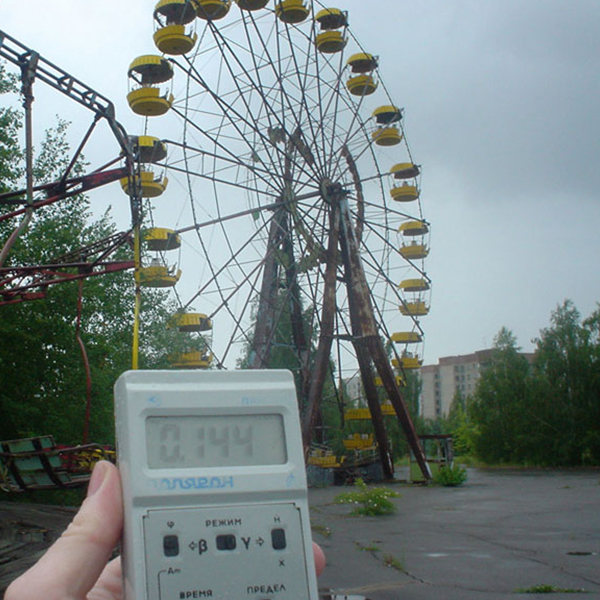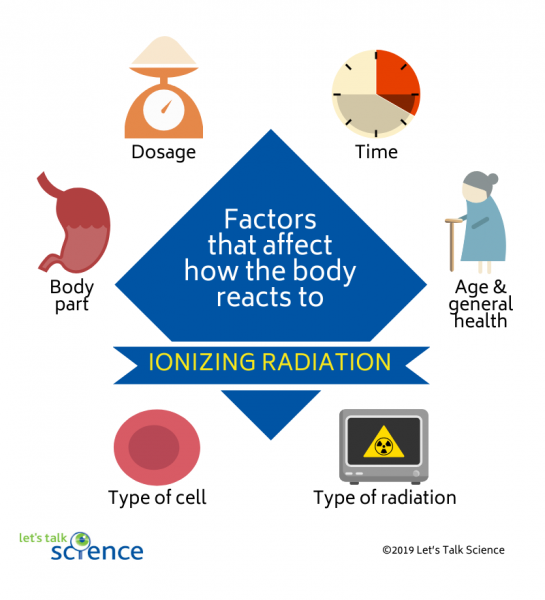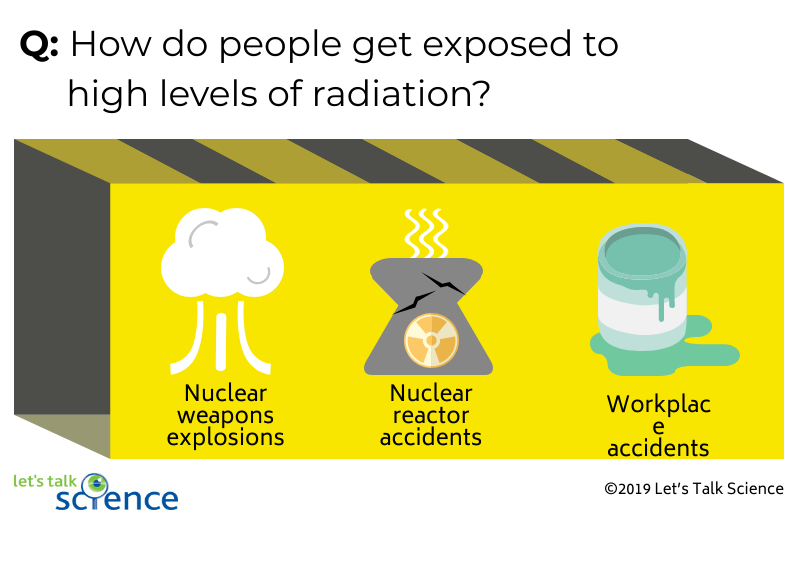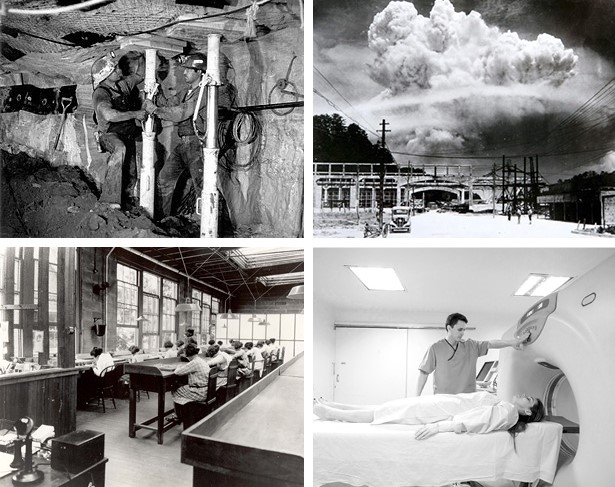Radiation Effects on the Body

Measuring radiation in Chernobyl (petedog, flickr [CC BY-NC-SA 2.0])

Measuring radiation in Chernobyl (petedog, flickr [CC BY-NC-SA 2.0])
How does this align with my curriculum?
| Grade | Course | Topic |
|---|
This backgrounder explains the potential effects of radiation on the human body.
Spider Man, the Incredible Hulk, Daredevil… what do all of these superheroes have in common? They all got their powers through radiation!
In real life, exposure to radiation can cause all kinds of effects. Unfortunately, scientists have learned that gaining superpowers is not one of them. Instead, effects can range from mild burns to lethal cancers.
To judge the impact of radiation on a person, scientists have to consider two factors. They have to look at how much radiation the person was exposed to. They also have to look at over how much time that exposure took place.
Several factors affect how the human body reacts to ionizing radiation. These include:
- the dosage (amount of radiation received)
- the time over which the dose is received
- the cells that are affected
- the part of the body that is affected
- the type of radiation
- the age and general health of the person

What are the acute effects of radiation exposure?
High doses of radiation over short periods of time produce acute (severe), short-term effects. High doses of radiation tend to kill cells. This damages tissues and organs. All of this can lead to a whole body response called Acute Radiation Syndrome (ARS). ARS can end in death.
People can be exposed to high doses of radiation in a few different ways. Examples include nuclear weapon explosions, nuclear reactor accidents and workplace accidents.

What is a lethal dose of radiation?
Scientists calculate the lethal dose of radiation using the number of expected deaths over a period of time after the exposure.
Ionizing radiation is measured with a Geiger counter in units called Sieverts. A lethal dose of ionizing radiation is expected to cause 50 percent of an exposed population to die within 30 days following the exposure. A lethal dose is about 4-5 sieverts. In Canada, the recommended limit of exposure to ionizing radiation is one millisievert per year, or 0.001 sieverts. That’s 4000 times lower than a lethal dose!
Very high doses of radiation do not tend to result in immediate death. However, they can result in skin burns, hair loss, vomiting, sterility, and cataracts (clouding of the lens of the eye).
Did you know?
The Chernobyl Disaster is considered the worst nuclear incident to date. Because of this nuclear explosion, over 220 000 people had to leave their homes. The incident happened in 1986, but the Chernobyl area is still experiencing radioactive effects today.
What are the chronic effects of radiation exposure?
Low doses of radiation over long periods of time can produce chronic (long-term) effects. Low doses do not tend to cause immediate problems to tissues and organs. But over the long term, they can damage or alter the genetic code (DNA mutations). This damage can happen in both gametes and somatic cells. Gametes are reproductive cells. DNA mutations in gametes can be inherited by children. These children might grow or develop at slower rates. Somatic cells are non-reproductive cells. Mutations in somatic cells can cause cancer.
Radiation is an example of a physical carcinogen (cancer-causing agent). Many studies have linked cancer with occupational or accidental exposure to radiation. Some examples include:
- lung cancer in uranium miners
- leukemia (blood cancer) in atomic bomb survivors
- bone cancer in radium dial (glowing part in wrist watches) painters
- skin cancer in radiologists

Radiation exposure to embryos can lead to malformations and early childhood cancer. This happens because of radiation doses much higher than the average person experiences from natural or everyday exposures. Some human activities can lead to radiation exposure. Examples include getting an x-ray, wearing a watch that lights up, or using an ionization smoke detector.
Keep in mind that not all radiation is dangerous. Scientists have not observed any health effects at the lowest doses of typical radiation exposure. Lowest doses range from natural background levels up to hundreds of times this level. Some scientific evidence suggests that these lowest levels of radiation may actually have benefits. This is similar to how some chemical toxins are dangerous at high doses but helpful at low doses. This phenomenon is called hormesis.
One final word
It is true that ionizing radiation can cause DNA mutations. But it is important to remember that these mutations never result in any kind of amazing superpowers. No one has ever started web-slinging after radiation exposure! Very rarely, a DNA mutation will be beneficial for an organism. It might even spread through a population via natural selection. But the advantage of such a mutation is usually subtle. For example, you likely wouldn’t gain the ability to self-ignite from radiation. But you might end up with a slightly better enzyme.
Lots of DNA mutations are neutral, with no advantages or disadvantages. However, many are lethal or harmful. That’s why it is a good idea to keep one’s exposure to ionizing radiation to a minimum level. This minimum level is commonly called As Low As Reasonably Achievable (ALARA). This is the official policy in Canada and other countries.
Did you know?
Many of the superheroes who got their powers from radiation were created in the 1960s. Back then, scientists did not understand the full effects of radioactivity. Many comic book creators were being hopeful!
Learn More
Radiation Health Effects (2019)
This page from the Canadian Nuclear Safety Commission explains the risks of radiation and its effects on human DNA.
From the Outside In: Biological Effects of Radiation (2019)
This lesson plan from TeachNuclear for Grades 7-12 includes Canadian provincial curriculum alignment, assignments and quizzes.
A Brief History of Nuclear Accidents Worldwide (2013)
This article from the Union of Concerned Scientists outlines seven nuclear accidents and how they happened.
The Nuclear Option: 15 Radioactive Superheroes and Villains (2017)
This article by Jonathan H. Kantor describes comic book characters whose powers are based on radiation.
Atomic Bomb History (2019)
This article from History.com, with video and images, outlines the history of atomic bombs around the world.
References
Canadian Centre for Occupational Health and Safety. (2019). Radiation - Quantities and units of ionizing radiation.
United States Environmental Protection Agency. (2018). Radiation health effects.
United States Nuclear Regulatory Commission. (2019). Lethal dose (LD).